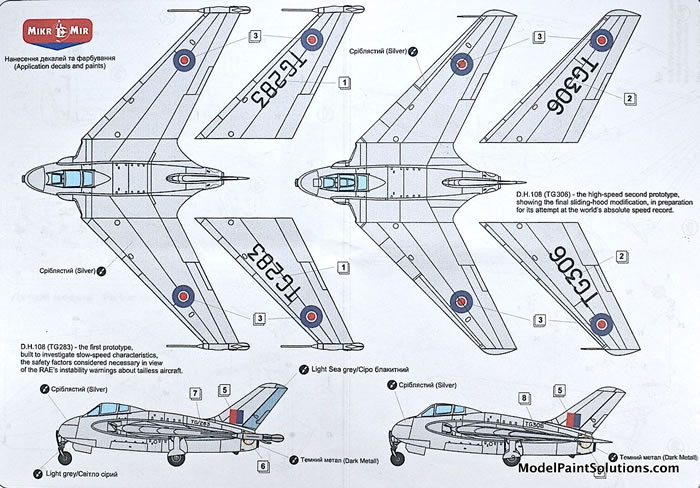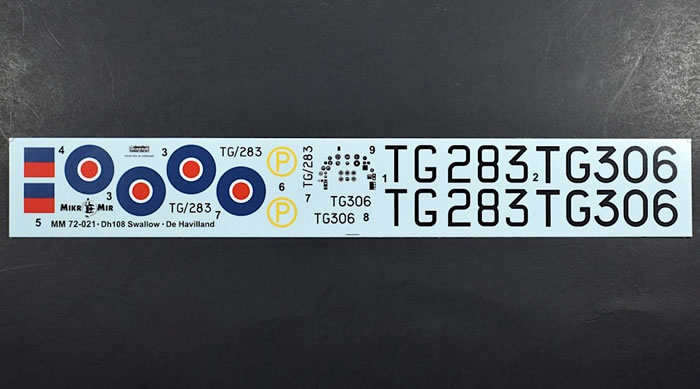DeHavilland DH.108 Swallow

MikroMir, 1/72 scale
S
u m m a r y : |
Description and Item No.: |
MikroMir Kit No.72022 - DeHavilland DH.108 Swallow |
Contents and Media: |
Four short run injection molded sprues in grey, one in clear, a small decal sheet, and a set of masks. |
Price: |
from GBP£20.67 plus shipping at Hannants |
Scale: |
1/72 |
Review Type: |
First Look |
Advantages: |
A nice-looking kit with a low parts-count . |
Disadvantages: |
A small amount of flash on a few parts. |
Recommendation: |
This is a nice-looking kit with a low parts-count and surely the easiest way to get a DH.108 into your 1/72 collection. I wonder if Mikro Mir will follow on with a kit of VW120, the most famous of the Swallows? |
Reviewed by Jim Bates
Phorography by Dr. Strangebrush

A Supersonic Delta?
It seems hard to relate to today, but post World War Two, British aviation manufactures were at the leading edge of jet technology. In those early days of jet design, it seemed like an almost anything goes environment. While the DH.108 was in some ways a swept wing Vampire, it was highly influenced by German designs like the Me 163 and the Lippisch P.13a “paper project.” It was also the first British jet “research” aircraft designed solely for flight test and research.
Originally considered a swept wing, tailless demonstrator for the DH.106 Comet, the aircraft was used for swept wing testing after a more conventional design was agreed upon for the Comet. It was originally built to meet the Air Ministry’s January 1946 Specification E.1/45. While often referred to as the Swallow, this was not an official de Havilland designation. The first two DH.108s used Vampire Mk. I fuselages with new metal swept wings. The third aircraft used a Vampire FB.5 fuselage, a larger Goblin engine, a substantially more streamlined nose and canopy, and featured a strengthened airframe and an ejection seat.

The prototype TG283, which first flew on May 15,1946, was optimized for low-speed testing with fixed wooden slats. This aircraft was demonstrated by Geoffrey de Havilland Jr., son of the firm founder Geoffrey de Havilland, at 1946 Society of British Aircraft Constructors (SBAC) airshow. The second prototype, TG306, designed for high-speed testing with retractable slats, first flew during June 1946. The final prototype, VW120, flew a year later on July 24, 1947.
Sadly, all three DH.108s were destroyed in fatal crashes. TG306 broke up during high-speed testing on September 27, 1946, killing test pilot Geoffrey de Havilland Jr. as he prepared to break the World Air Speed Record. The third prototype, VW120, did set a new world 100 km closed-circuit speed record in April 1948 and was the first British aircraft to break the sound barrier on September 6, 1948. Unfortunately, the third prototype was destroyed in a fatal crash on February 15, 1950, due to pilot incapacitation. Lastly, TG283 was destroyed in a crash on May 1, 1950, during low-speed tests. Maybe Eric ‘Winkle’ Brown was correct. After he flew the Swallow he wrote in his logbook “A Killer. Nasty Stall. Vicious undamped longitudinal oscillation at speed.”
The DH.108 in Plastic
The first kit of the DH.108 was issued in the mid 70s by the British Columbia vacuform firm Airframe. A few additional vacuform and resin kits have appeared over the years, but Mikro Mir’s is the first injection molded Swallow in any scale.
The Mikro Mir Kit
Disclaimer: Only the first two prototypes of the Swallow can be built from this kit. VW120 was a substantially different looking aircraft, and the parts are not included to model this version.
The kit consists of four short run injection molded sprues in grey, one in clear, a small decal sheet, and a set of masks.
The largest components are the swept wings, and all plastic parts include fine recessed surface detail. While this is a short run kit, the plastic parts are well-molded, and the detail is quite crisp. There is a small amount of flash on a few parts, but nothing that cannot be cleaned up in a few minutes.
Many of the larger parts, for example the fuselage and wings, have the runner attachment points on the gluing surfaces. I’ve seen this in more mainstream kits, but it is a first for me in a short run kit.

The two canopies are quite clear, but there are some molding flaws and distortion in my example.
Markings
The decal sheet is quite small but includes markings for both TG283 and TG306. Sorry, but you can paint your Swallow any colour you want as long as it is High-Speed Silver.

The masks are die-cut thin vinyl; not the usual Tamiya-like tape used by Eduard.
Note
The instructions are not quite clear as to the options. Two canopies are provided, and I believe that part number 16 is for TG283, and part 17 is for TG306. If that is indeed the case, the instructions are also incorrect as to the rear portion of part 17, which should be painted and not left clear as illustrated in the paint diagram. Both “normal” wing tips and pods with pitot tubes are included; these contained anti-spin parachutes. Only TG283 carried these pods, so if you are fitting the “normal” wingtips, you will need to supply your own pitot tubes. Finally, no fixed slats are provided for TG283.
This is a nice-looking kit with a low parts-count and surely the easiest way to get a DH.108 into your 1/72 collection. I wonder if Mikro Mir will follow on with a kit of VW120, the most famous of the Swallows?
Cheers!
—Jim
For more on this review visit Modelpaintsolutions.com
https://modelpaintsol.com/reviews/mikromir-72-dehavilland-dh-108-swallow-72022
Review Text and Images Copyright © 2022 by Jim Bates/Model Paint Solutions
Page Created 15 September, 2022
Last updated
15 September, 2022
Back to HyperScale Main Page
Back to Reviews Page

|
Home
| What's New |
Features |
Gallery |
Reviews |
Reference |
Forum |
Search